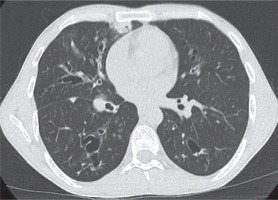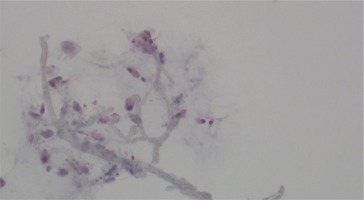INTRODUCTION
Allergic bronchopulmonary aspergillosis (ABPA), caused by A. fumigatus, occurs in patients with a history of asthma or cystic fibrosis. The diagnosis of asthma usually precedes ABPA for over 10 years1,2. We present a case of concomitant diagnosis of ABPA and asthma in a 26-year-old immigrant from Afghanistan.
METHODS
A 26-year-old male presented with a 3-week history of dyspnea on exertion, chest tightness and productive cough with excretion of copious purulent secretions. The patient did not report fever, weight loss or haemoptysis. He had no history of asthma or atopy. Physical examination revealed a respiratory rate of 19/min and SpO2 of 95% on room air, polyphonic wheezing, crackles in middle lung zones and significant digital clubbing.
RESULTS
Laboratory results were significant for an eosinophil count of 2350 cells/ μL and IgE levels were above the measurable amount of 10.000 IU/mL. Sputum Gram and Ziehl–Neelsen stains were negative. PPD reaction was 16 mm. High resolution CT of the chest revealed bilateral cylindrical and cystic bronchiectasis with finger-in-glove sign, mucous plugs, and a tree-in-bud pattern (Figure 1). Spirometry revealed an obstructive profile with a post-bronchodilation FEV1 of 55%, FEV1/FVC of 67% and reversibility above 12% and 200mL. BAL Ziehl–Neelsen stain and PCR for tuberculosis were negative. Direct microscopy revealed the presence of hyphae, confirmed to be A. fumigatus (Figure 2). Specific Aspergillus IgE and IgG titers were increased. The patient received oral corticosteroids and itraconazole; his symptoms improved, and he was discharged.
CONCLUSIONS
Although a diagnosis of asthma usually precedes ABPA for more than a decade1, this case demonstrates that ABPA and asthma can present concomitantly in patients with unremarkable past medical history.



